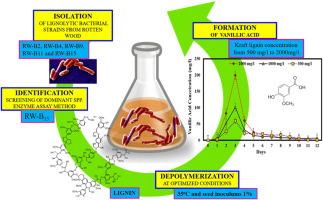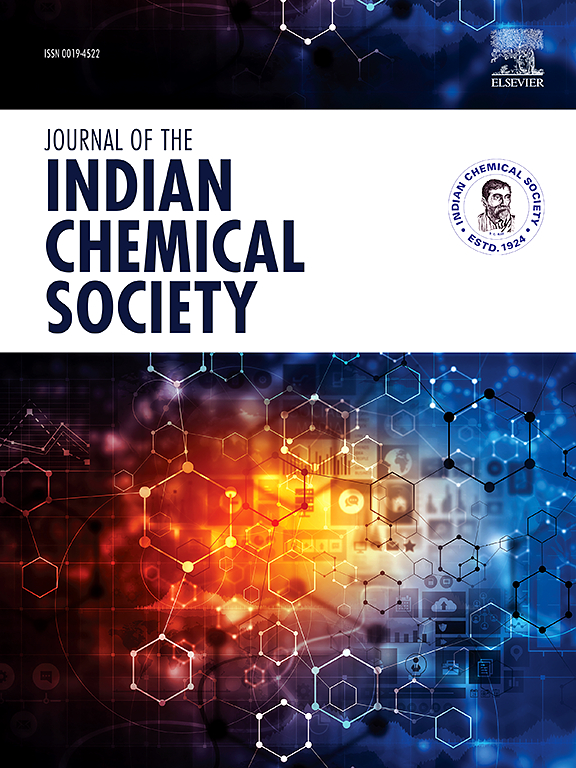利用本地木质素分解菌株对牛皮纸木质素进行微生物解聚以生产香草酸
IF 3.2
4区 化学
Q2 CHEMISTRY, MULTIDISCIPLINARY
引用次数: 0
摘要
木质素是一种潜在的可再生资源,可通过细菌解聚作用生产多种高附加值的生物产品。在这项研究中,本地潜在的木质素分解菌株对牛皮纸木质素(KL)进行了解聚,以获得最佳量的香草酸。最初,从腐木混合土壤中分离出 15 种细菌菌株,以评估它们的木质素降解效率。通过营养富集技术,确定了五种潜在的木质素降解微生物(RW-B2、RW-B4、RW-B9、RW-B11 和 RW-B15)。最佳温度和细菌接种浓度分别为 35 °C 和 1%。五种潜在的木质素分解菌株的混合微生物培养显示出比纯培养物更好的 KL 降解效果,这是因为联合体成员之间的代谢能力、酶作用机制和协同影响各不相同。在最佳温度下,使用 1 % 的接种物对不同浓度(500-2000 mg/l)的 KL 进行了降解研究。随着 KL 浓度从 500 毫克/升到 2000 毫克/升的增加,香草酸的产量从 60.1 毫克/升增加到 199.9 毫克/升。香草酸的产量在降解的第三天达到最大值,之后有所下降,这可能是由于微生物毒性和酶活性的增加。然而,随着降解时间的延长,所有 KL 浓度的 COD 水平都持续下降,直到最后一天。由于香草酸呈酸性,KL 溶液的 pH 值在第三天略有下降。气相色谱-质谱分析证实了香草酸的存在,并显示了 KL 降解后形成的其他单体化合物的存在。本文章由计算机程序翻译,如有差异,请以英文原文为准。

Microbial depolymerization of Kraft lignin for production of Vanillic acid by indigenous ligninolytic strains
Lignin is a potential renewable source for the production of many value-added bio-products through bacterial depolymerization. In this study, Kraft lignin (KL) was depolymerized by indigenous potential ligninolytic strains to obtain the optimum amount of Vanillic acid. Initially, fifteen bacterial strains were isolated from decaying wood mixed soil to assess their lignin degradation efficiency. Five potential lignin-degrading microbes (RW-B2, RW-B4, RW-B9, RW-B11 and RW-B15) were identified by nutrient enrichment technique. RW-B15 was observed as a dominant strain sharing a 99 % resemblance to Bacillus megaterium sp. Optimum temperature and bacterial inoculum concentration were noted as 35 °C and 1 %, respectively. Mixed microbial culture of five potential ligninolytic strains showed better KL degradation than pure culture due to different metabolic capacities, enzymatic mechanisms and synergetic impact among the association members. The KL degradation study was conducted with different KL concentrations (500–2000 mg/l) at optimum temperature using 1 % inoculums. The production of Vanillic acid increased from 60.1 to 199.9 mg/l with increasing concentration of KL from 500 to 2000 mg/l. The maximum production of Vanillic acid was obtained on 3rd day of degradation and it decreased thereafter which is probably due to an increase in microbial toxicity and enzymatic activity. However, the COD level continuously decreased for all KL concentrations with degradation time till the last day. The pH of the KL solution slightly decreased on 3rd day due to the acidic nature of Vanillic acid. GC-MS analysis confirmed the presence of Vanillic acid and showed the presence of other monomeric compounds formed after KL degradation.
求助全文
通过发布文献求助,成功后即可免费获取论文全文。
去求助
来源期刊
CiteScore
3.50
自引率
7.70%
发文量
492
审稿时长
3-8 weeks
期刊介绍:
The Journal of the Indian Chemical Society publishes original, fundamental, theorical, experimental research work of highest quality in all areas of chemistry, biochemistry, medicinal chemistry, electrochemistry, agrochemistry, chemical engineering and technology, food chemistry, environmental chemistry, etc.

 求助内容:
求助内容: 应助结果提醒方式:
应助结果提醒方式:


